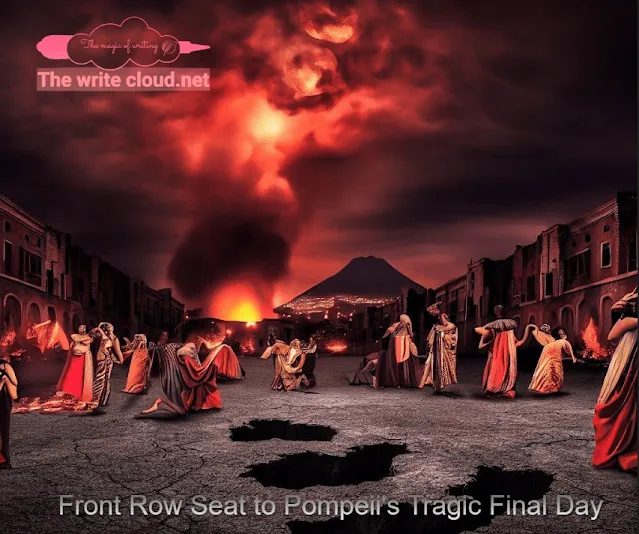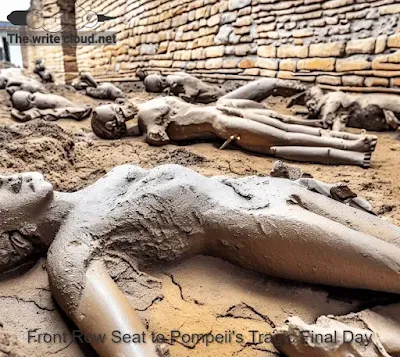A journey to Pompeii you'll experience the ancient city of Pompeii's final moments and glimpse humanity facing disaster.
Our journey through the past begins!
 |
| pompeii final moments |
Table of content
- Arrival in Pompeii
- Life in a Thriving Roman Town
- Panic Engulfs the Streets
- A Desperate Attempt at Escape
- Eyewitness to the Deadly Flows
- Rediscovering Pompeii's Secrets
- Lessons from Pompeii's Ashes
- Pompeii is a "sin city"
- Conclusion
- FAQs
Arrival in Pompeii
🚀 Today we step back to bustling the city of Pompeii, a thriving Roman town
along the glorious Bay of Naples. Marvel at colonnades and explore markets as
I recount daily life. But darkness soon falls by dusk, and Pompeii meets a
cataclysmic end.
💨After we get to Pompeii, let's know ???!
What Was Pompeii?
Pompeii was an ancient Roman town located near modern Naples, along the
Bay of Naples. It was founded in the 6th century BC by the Oscan-speaking
Samnites. Centuries later in 80 BC, it came under Roman control and became a
fashionable resort for wealthy Romans due to its scenic location and
climate.
By the 1st century AD, pompeii had grown to cover about 120 hectares and boasted 20,000 inhabitants within its walls. As a major port and resort destination, Pompeii's economy relied on agriculture, craftsmanship, and trade.
👉After we did a quick overview of Pompeii, let us know
Life in a Thriving Roman Town
What activity surrounds us in the ancient city of pompeii! Shops overflow with goods pottery, oil, and bread filling the air with scents. Carts rumble towards forums and
marketplaces buzzing with people
as you see It's a warm
summer morning in the city of "Pompeii", gazing in awe at grand colonnades, temples, and
opulent villas housing 20,000 residents. We visit the renowned 🛀
Stabian Baths for rest and relaxation.
Nearby 🏛 villas boast magnificent
mosaics and frescoes, 💃showcasing Bacchus and Neptune through vibrant colors.
🎭Theaters and gladiator competitions are tonight's prime entertainment.
Truly, Pompeii flourishes as a leading port town!
After taking this journey you've noticed the
Daily Life in Pompeii
- busy streets filled with merchants' calls. Olive oil, dried fish, and pots are the day's wares.
- Farmers' carts roll in with crops.
- The Forum bustles with legal disputes and civic meetings.
- Past grand temples and colonnades,
- unwind in the Stabian Baths.
- vivid frescoes in great villas
- vivid depictions of Bacchus in the House of the Faun.
- gladiator battles and debates at nearby theatres.
- a comedy performance lightening moods on this hot summer day.
By dusk, taverns and homes fill with lively conversation after
a day's labor in this flourishing Roman town.
😯 Our tour ends let's see what happens next
Panic Engulfs the Streets
As you see, ominous signs appeared. Earth tremors unsettle homes while geysers
erupt from 🌋Mount Vesuvius, ever-watchful over Pompeii. 🐾Animals flee
in a panic.🌧 foreboding dark clouds gather heavy with threats of rain
yet the warmth persists, 🍃nature-made winds failing to blow. Priests see the
gods' warnings but life proceeds as usual. Little do we know the darkness
ahead will shroud Pompeii for eternity.
How horror fills the night
😲Did you feel How Such horror fills the night! look at The sky and see how it glows hellish-red against thick, roiling ash. Scalding debris rains upon us as crowds clog roads in a terrified frenzy.
Families cling desperately together amid the chaos. Buildings crumble under the shaking earth's wrath. By dawn, an immense column towers where Vesuvius once stood proud
😢 Now an endless plume pours its fury upon the city of Pompeii without mercy. None
shall escape its path.
A Desperate Attempt at Escape
I guide my kin towards the city of pompeii gates, pleading all to keep hope. But the
deadly flows overtake the outskirts within minutes, their fiery wrath
consuming flesh before skin burns. Sheltering underground offers little relief
from the onslaught above. Collapsing structures signal our imminent end. By
daybreak, only a suffocating darkness remains where sunlight once shone over
lively Pompeii.
How Pompeians Met Their Demise
Many retreats indoors to outlast the onslaught, but walls and roofs
can't impede the pyroclastic tide. Some writhe helplessly, flesh melting off
until blackened corpses strain inside shells of fused ash and bone. A lucky
few may expire from building collapses before arriving clouds scorch living
tissues from muscle down to cellular structures within seconds.
😔 city of Pompeii
succumbs entirely within hours, its inhabitants entombed under 16-20 feet of
scalding ash, rock, and pumice.
😨Now, only silence.
Eyewitness to the Deadly Flows
Did you see how the pyroclastic flow moves faster than any human
can outrun overtaking within two minutes. Those near the surging edge fall
instantly unconscious from intense heat and ash inhalation before skin burns
away and bones char.
ِ
A trader caught near Vesuvius, tells of the horrors:
"An endless hellstorm swallowed the mountain.
Searing winds melt skin within seconds as we collapse. Lungs are filled
with ash instead of air. Those near outlast mere moments of agony before
blackening where they fall.”
as we capture the literal hell unleashed none survived temperatures
over 300°C. Through his testimony, we glimpse the terrifying fate that
consumed 20,000 souls in an instant.
Entombed in Ash, Preserved for
Eternity
For 16 centuries,ancient city of Pompeii lay dormant in slumber. All changed with its unearthing skeletons emerging locked in final poses, skins, and features intact thanks to volcanic ash filling cavities left behind. Handprints and faces locked in torment testify to souls trapped within moments of their demise.
💔Anonymous victims remind us of our fleeting lives against
nature's wrath. Their accidental tomb grants future generations insight into
humanity at its most vulnerable yet profoundly human state...
Petrified Bodies Tell Their Story
Just how were Pompeians transformed into remarkable mummies? The
phenomenon is rooted in Vesuvius' eruption characteristics. When the super-heated
pyroclastic flows (300-465°C / 572-869°F) engulfed victims, cells started
vaporizing as body water boiled away.
 |
| Pompeians transformed into remarkable mummies |
Meanwhile, volcanic ash filled cavities left by evaporated body fluids and tissues. Over time, the ash deposited minerals consolidating remaining organic structures into casts of the original flesh. Moist body parts like hands fused into the ubiquitous mannequin-like "pose" position.
Where victims died shielding faces, imprints of features like eyebrows,
eyelashes, and distressed expressions remained permanently preserved. Pompeii's
"frozen" remains continue recounting their final struggles through centuries,
immortalizing humanity in extinction's throes.
Rediscovering Pompeii's Secrets
Archaeologists painstakingly uncover vibrant frescoes within preserved structures, along with household items frozen where they fell. Bakeries hold intact loaves from that horrific day while woodcarvings retain intricate details even after two millennia.
Skeletons of citizens and animals mingled in death's instant moment. Most
chillingly, molten casts form those overcome in the surging flows, forever
encased in its hellish turbulence. Through silent witnesses from antiquity, we
glimpse daily life in Pompeii before its abrupt end a living glimpse into the
past.
Lessons from Pompeii's Ashes
Though reduced to ruins, life's spirit prevails through shared memories
of its people. Their resilience and compassion live on kindness alone defines
civilizations, not nature's destructive forces. Future generations rose from
these ashes to rebuild through the human capacity to overcome tragedy.
👐Let Pompeii humble us in our fragility yet give hope that solidarity
and care for one another allows even societies reduced to ashes to flourish
anew. Its preservation immortalizes humanity's victories over even Death.
Pompeii is a "sin city"
Pompeii was sometimes called a "sin city" due to the risqué frescoes,
brothels, and evidence of debauchery found during archaeological
excavations. Here are some of the key reasons:
Explicit frescoes:
Paintings depicting sexual acts and phalluses were found decorating homes,
shops, and taverns. This included what is known as the "Sex Room" fresco
showing intercourse and kissing.
Brothels uncovered:
Archaeologists discovered brothels throughout Pompeii with small rooms
containing sexual murals. Items also pointed to prostitution like
coin-operated sex machines called "pestles".
Sex items found:
Artifacts suggested a sex-positive culture, like glass phallic amulets
believed to ward off the "evil eye". Bones of newborn infants have been found,
hinting at birth control and abortion practices.
Graffiti vulgarities:
Crude jokes, poems, and insults littered Pompeii's streets, pointing to a
libertine social attitude. Obscenities referenced sex acts, body parts, and
even graphic accusations against public figures.
Roman values differed:
By today's standards, ancient Rome was relatively permissive of sex outside of
marriage, prostitution, and even pederasty. Pompeii reflected the era's values
towards sexuality before Christianity's rise.
Tourism appeal:
The explicit frescoes and lascivious finds fueled Pompeii's reputation as a
decadent look into Roman hedonism, drawing tourism even in its excavated
ruins. This reputation as a bastion of uninhibited pursuits stuck through the
centuries.
👀 So in summary, Pompeii's status as a "sin city" emerged
from the sexualized artworks, artifacts of debauchery, and libertine culture
uncovered there during archaeological digs across the buried Roman town.
Conclusion
And so our journey through history comes full circle to the lively streets of reborn Pompeii. Though time reduces all things to dust, some treasures like compassion persist through the ages, and hope is still nourished worldwide by your eternal example.
👼 Rest now, sons and daughters of Pompeii assured of your sacrifice to protect
others' lives as inspiration for kindness through suffering. Your undying
story of overcoming tragedy through unity revives the human spirit for all
time. Farewell, and thank you for sharing your history it was an honor.
FAQs
What was Pompeii?
An ancient Roman port town near Naples, thriving until buried by
Vesuvius' 79 AD eruption.
How did Pompeians live?
Through vibrant social interaction, leisure activities, commerce, and
admired art within a tight-knit community.
Why is it called the "frozen city"?
Its inhabitants and structures were preserved in ash for over 16
centuries, creating lifelike "mummies" offering insights into Roman
culture.
How were bodies converted into "mummies"?
Most were incinerated or asphyxiated within minutes as pyroclastic flows over
465°F engulfed the city from Vesuvius, scorching lungs on contact. Others
succumbed to ash falls or building collapses by dawn.
Ash-filled cavities are left by vaporized fluids, trapping skins, hair, and features
which minerals then crystallize into a state of eerie preservation.

Post a Comment